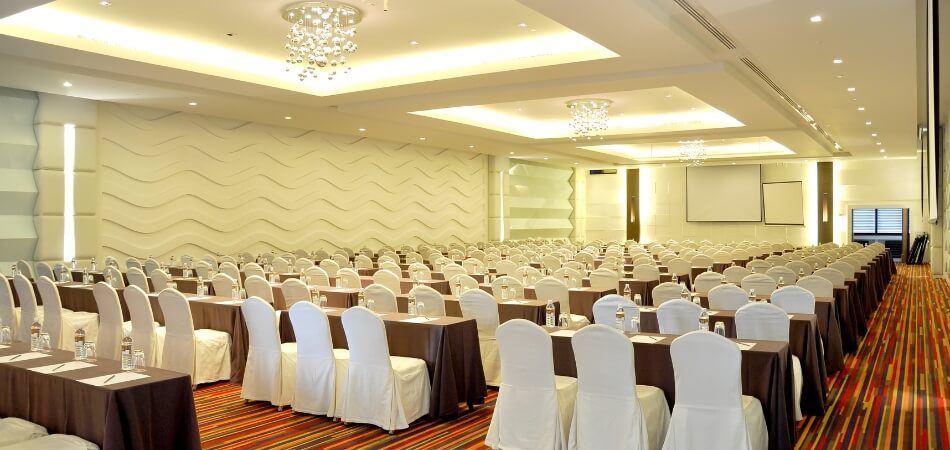The size of a conference room plays a vital role in facilitating effective communication and interaction among participants. It sets the tone for comfort and efficiency, influencing how smoothly meetings can be conducted. A well-sized room can increase focus, minimize distractions, and promote productive exchanges. So, how big should a conference room be?
Ideally, small rooms around 10′ x 10′ (3m x 3m) are perfect for seating 4-6 people, while medium rooms about 20′ x 20′ (6m x 6m) accommodate 8-12 attendees. For larger gatherings, spaces measuring at least 30′ x 30′ (9m x 9m) can hold 16-20 individuals or more, depending on the arrangement.
Would you like to know how to optimize the dimensions of your conference room? We are going to take you on a journey through this article as we explore additional in-depth insights.
What Should You Know about Conference Rooms?
Conference rooms are essential spaces where ideas converge, and decisions are made. They come in various sizes, tailored to the number of participants. The right environment fosters creativity and ensures that all voices are heard. Proper acoustics and lighting also play a crucial role in maintaining concentration.

When planning a conference room, think about the technology you’ll need. High-quality video and audio systems are crucial for seamless communication. Flexible furniture arrangements can adapt to different meeting types. Remember, the space should be as dynamic as the discussions that occur within it.
How Big Should a Conference Room Be?
Determining the ideal size for a conference room depends primarily on its intended use and the number of attendees. For smaller meetings with 4-6 people, a room measuring about 10′ x 10′ (3m x 3m) should suffice. This size ensures that everyone can communicate effectively without feeling cramped. It’s also great for fostering a close-knit atmosphere where ideas can flow freely.

Factors Determine the Conference Room Size
Selecting the ideal size for a conference room is crucial to ensure meetings are both productive and comfortable. Different factors play a vital role in determining the right dimensions. Understanding these can help you decide the best size for a conference room that fits your specific needs.
Purpose of the Room
The main function of your conference room significantly influences the needed size. Rooms designed for formal board meetings usually require more space per individual. This extra room accommodates larger tables and ensures seating is comfortable for long discussions. Rooms aimed at creative sessions might be smaller to boost closeness and teamwork.
Number of Participants
Think about the usual number of people using the room. A smaller team of 4-6 might only need a compact space. As participant numbers grow, adjusting the room size becomes necessary to keep everyone comfortable. Proper planning ensures all attendees have ample space without feeling cramped.
Type of Furniture and Equipment
The layout and size of your furniture greatly affect the required dimensions of the room. Bigger tables and executive chairs take up more space than smaller, adjustable furniture. Also, the need for tech like projectors or whiteboards might mean needing more room. Planning for these elements ensures they complement rather than limit the space’s functionality.
Room Shape and Architecture
The shape and structural features of a room also affect its usability. A longer room might be better suited for a traditional boardroom setup than a square one. Knowing the architectural limits helps maximize the effectiveness of the available space. This is crucial to ensure the room meets its intended purpose well.
Type of Meeting
Different meetings require different settings. For instance, creative brainstorming sessions may need a more informal, flexible space. Conversely, formal board meetings demand a more structured environment, often with high-quality furnishings and a boardroom-style setup. The room’s design should align with the meeting’s tone and purpose, maximizing its overall productivity and effectiveness.
Available Space in Your Office Building or Home
The available space in your premises greatly influences the size of the conference room. In smaller buildings or homes, one must be creative with limited space. Maximizing the usability of the available area without compromising on comfort is a key challenge. Multi-functional furniture and smart design can help optimize smaller spaces for effective meetings.
Budget for the Room Size
Budget constraints play a significant role in deciding room size. Larger rooms generally require more investment in furnishings and technology. However, the cost must be balanced with the need for a functional meeting space. Investing wisely in a well-equipped room can help increase productivity and justify the expenditure in the long run.
Technology Requirements
Modern meetings often rely on technology, from video conferencing to presentations. The size of the room should accommodate these technological needs. Make sure the conference room you choose is indeed soundproof. Larger rooms may need more advanced audio-visual equipment to ensure everyone can see and hear clearly. Planning for these requirements in advance is essential for a seamless meeting experience.
Design Preferences
Personal or company aesthetic preferences also influence room size and layout. A minimalist design might favor a smaller, more efficient space. In contrast, a preference for luxury or a more traditional business aesthetic might call for larger, more opulent rooms. The design should reflect the company’s culture and ethos, creating an appropriate atmosphere for meetings.
Selecting the right size for a conference room involves balancing participant numbers, meeting types, and available space. Budget, technology needs, and design preferences also play crucial roles. Incorporating best practices for naming conference rooms enhances space functionality and identity, fostering productive and engaging meetings that meet user needs effectively.
What are the Common Sizes of Conference Rooms?
Conference rooms are a vital part of any business setting, serving various purposes, from small team huddles to large board meetings. The size of these rooms significantly impacts their functionality and the type of interaction they facilitate. Choosing the right size is key to ensuring effective communication and collaboration.
Smaller Rooms (2-4 People)
These intimate spaces are perfect for quick, focused discussions or one-on-one meetings. Typically ranging from 100 to 150 square feet, they offer a private and quiet environment. Equipped with minimal furniture, they’re ideal for small teams needing a space for uninterrupted work. Their compact nature fosters close collaboration and effective communication.
Medium-Sized Rooms (4-6 People)
Designed for small group meetings, these rooms span approximately 150 to 250 square feet. They often feature a central table, comfortable seating, and basic AV equipment for presentations. These rooms balance coziness with enough space to move freely, suitable for team meetings or client discussions. Their versatility makes them popular in many office settings.
Larger Rooms (6-10 People)
Accommodating 6 to 10 individuals, these rooms measure between 250 to 350 square feet. They are typically equipped with advanced technology for video conferencing and presentations. The larger space allows for a more traditional boardroom setup, which is ideal for formal meetings. Such rooms often feature high-end furnishings and are used for significant business discussions.
Very Large Rooms (More Than 10 People)
For gatherings exceeding 10 participants, rooms over 350 square feet are necessary. These spaces can host workshops, large team meetings, or training sessions. Equipped with state-of-the-art technology, they often have flexible seating arrangements. Their spaciousness is conducive to interactive sessions and larger group dynamics.
The size and type of a conference room should align with its intended use and the number of participants. Selecting the appropriate size ensures a comfortable, productive, and efficient meeting environment for all attendees.
Benefits of Having the Right Conference Room Size
The right conference room size can significantly improve the quality of meetings and the productivity of those involved. It creates an environment conducive to effective communication and collaboration. An organization’s ability to select the most appropriate size depends on its understanding of the benefits.
Enhanced Comfort and Accessibility
A conference room of the right size ensures that all participants are comfortable, with sufficient space to move and interact. Overcrowded rooms can lead to discomfort and distractions, undermining the meeting’s effectiveness.
In a well-sized room, accessibility is also enhanced. Participants can easily access seats, use equipment, and engage without physical constraints. This accessibility is vital for inclusivity and encourages active participation from all attendees.
Improved Communication and Engagement
The right-sized conference room fosters better communication among participants. In a space that is neither too cramped nor too spacious, attendees can interact more naturally and effectively.
A room that’s appropriately sized eliminates the feeling of emptiness in large rooms or the claustrophobia of small spaces. This balance is essential for maintaining focus and engagement throughout meetings, leading to more productive outcomes.
Optimal Use of Technology
In a correctly sized room, technology like video conferencing and presentation tools can be utilized effectively. There’s enough space to accommodate necessary equipment without overwhelming the room.
The size also influences the effectiveness of audio-visual elements. In a room that’s too large or too small, these elements might not function optimally, affecting the quality of presentations and communication.
Adaptability for Various Meeting Types
The right-sized conference room offers flexibility to accommodate different types of meetings, from formal board meetings to creative brainstorming sessions. It allows for various seating arrangements and setups, catering to specific meeting requirements.
This adaptability ensures that the room can be efficiently used for multiple purposes, making it a critical consideration when selecting a conference venue. A versatile space is an asset to any organization, accommodating a wide range of meeting styles and needs, thus increasing its utility and return on investment.
Selecting the right conference room size has numerous benefits, including enhanced comfort, improved communication, optimal use of technology, and adaptability for various meeting types. It is a strategic decision that impacts the effectiveness of collaborations and the overall productivity of an organization. Making an informed choice in this regard is key to facilitating successful and productive meetings.
Tips to Help You Utilize the Conference to the Fullest
The experience of attending a conference can be transformative if you know how to make the most of it. With the right strategies, you can leverage every session and interaction to benefit your personal and professional growth. Here are some practical tips to help you utilize the conference to the fullest:
- Plan Ahead: Research the agenda and speakers before the event starts. This preparation lets you prioritize sessions that align with your interests.
- Network Effectively: Introduce yourself to new people at every opportunity. Making connections can lead to valuable insights and future collaborations.
- Take Notes: Capture key points and ideas during sessions. Reviewing these notes later can reinforce your learning and spark new ideas.
- Engage Actively: Participate in discussions and ask questions. Engaging with content directly enhances your understanding and retention.
- Follow-up: Connect with people you met after the conference. Sending a quick email or connecting on LinkedIn can solidify new relationships.
- Reflect Daily: Spend a few minutes each evening to reflect on the day’s learnings. This helps you process information and plan the next day’s activities.
You can maximize your conference experience by being proactive and engaging deeply with the content and people you meet. Implement these tips to ensure you come away with valuable knowledge and connections that can impact your career long after the event has concluded.
Frequently Asked Questions about How Big Should a Conference Room be?
A conference room’s size is crucial for ensuring functionality and comfort during meetings. To help you make the best decision, here are some frequently asked questions with detailed answers about determining the appropriate conference room size.
What Size Should a Small Conference Room Be?
A small conference room typically measures around 10′ x 10′ (3m x 3m) and comfortably seats 4-6 people, making it ideal for intimate meetings or small team collaborations.
Is There a Recommended Size for Medium-sized Conference Rooms?
For a medium-sized conference room, around 20′ x 20′ (6m x 6m) is advisable. This size can seat 8-12 people and is perfect for regular departmental meetings or client presentations.
How Large Should a Conference Room Be for 20 People?
A large conference room intended for 16-20 people should be at least 30′ x 30′ (9m x 9m). This size accommodates various seating arrangements and allows for comfortable movement and interaction.
Does the Purpose of the Meeting Affect the Size of the Conference Room?
Yes, the purpose significantly influences room size. Formal board meetings might require more space per person compared to creative sessions, which may benefit from a cozier setting to encourage interaction.
How Do I Calculate the Ideal Conference Room Size for Different Layouts?
Consider the layout: theater style needs less space per person than a classroom setup. Multiply the number of attendees by the space needed per layout to estimate the required room size.
What Should I Consider Beyond Basic Measurements for a Conference Room?
Beyond measurements, consider the need for extra space for equipment, such as projectors and whiteboards, and whether the room will need areas for people to break into smaller groups.
Bottom Lines
In order to maximize meeting effectiveness, it is crucial to choose the right conference room size. Aligning space with meeting types fosters productivity and engagement within the organization.
Questions like “How big should a conference room be?” are crucial for optimizing functionality. Proper sizing ensures comfort, enhances communication, and uses technology effectively, leading to successful meetings. A well-planned room serves as a vital asset, boosting business objectives and professional growth.






